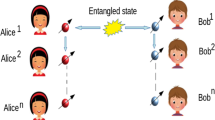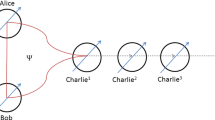Abstract
Genuine entanglement serves as a valuable resource for multipartite quantum information processing. Recently, the ability to share the genuine entanglement among a long sequence of independent observers has gained considerable attention, especially when the state preparation faces significant limitations. Firstly, this paper focuses on investigating the sharing ability of genuine tripartite entanglement under unilateral sequential measurements. We propose a measurement strategy for generalized tripartite Greenberger-Horne-Zeilinger (GHZ) states to enable arbitrarily long sequence of independent observers to detect the genuine entanglement using entanglement witnesses. Moreover, when the sharpness parameters of each sequential observer’s measurement settings are equal, we give the correlation between the controllable angle of generalized GHZ state and the maximum number of sequential observers capable of detecting genuine entanglement. In particular, we identify the controllable angle range within which the same number of such observers can be achieved for generalized GHZ states as with the maximally entangled GHZ state. We also determine the controllable angle range for generalized tripartite \(\varvec{W}\) states, where the number of sequential observers can be same as that with maximally entangled \(\varvec{W}\) state. Furthermore, we design a measurement strategy for the trilateral sequential scenario, demonstrating that the genuine tripartite entanglement of any generalized GHZ state can be shared by arbitrarily many groups of observers.



Similar content being viewed by others
References
Pironio, S., Acín, A., Massar, S., et al.: Random numbers certified by Bell’s theorem. Nature 464, 1021 (2010)
Ekert, A.K.: Quantum cryptography based on Bell’s theorem. Phys. Rev. Lett. 67, 661 (1991)
Barrett, J., Hardy, L., Kent, A.: No signaling and quantum key distribution. Phys. Rev. Lett. 95, 010503 (2005)
Gühne, O., Tóth, G.: Entanglement detection. Phys. Rep. 474, 1 (2009)
Guhne, O., Seevinck, M.: Separability criteria for genuine multiparticle entanglement. New J. Phys. 12, 053002 (2010)
Scarani, V., Gisin, N.: Quantum communication between \(N\) partners and Bell’s inequalities. Phys. Rev. Lett. 87, 17901 (2001)
Murao, M., Jonathan, D., Plenio, M.B., Vedral, V.: Quantum telecloning and multiparticle entanglement. Phys. Rev. A 59, 156 (1999)
Hyllus, P., Laskowski, W., Krischek, R., Schwemmer, C., et al.: Fisher information and multiparticle entanglement. Phys. Rev. A 85, 022321 (2012)
Chruściński, D., Sarbicki, G.: Entanglement witnesses: construction, analysis and classification. J. Phys. A 47, 483001 (2014)
Horodecki, R., Horodecki, P., Horodecki, M., et al.: Quantum entanglement. Rev. Mod. Phys. 81, 865 (2009)
Gühne, O., Hyllus, P.: Investigating three qubit entanglement with local measurements. Int. J. Theor. Phys. 42, 1001 (2003)
Uffink, J.: Quadratic Bell inequalities as tests for multipartite entanglement. Phys. Rev. Lett. 88, 230406 (2002)
Mermin, N.D.: Extreme quantum entanglement in a superposition of macroscopically distinct states. Phys. Rev. Lett. 65, 1838 (1990)
Brunner, N., Cavalcanti, D., Pironio, S., et al.: Bell nonlocality. Rev. Mod. Phys. 86, 419 (2014)
Clauser, J.F., Horne, M.A., Shimony, A., et al.: Proposed experiment to test local hidden-variable theories. Phys. Rev. Lett. 23, 880 (1969)
Aharonov, Y., Albert, D.Z., Vaidman, L.: How the result of a measurement of a component of the spin of a spin-1/2 particle can turn out to be 100. Phys. Rev. Lett. 60, 1351 (1988)
Brown, P.J., Colbeck, R.: Arbitrarily many independent observers can share the nonlocality of a single maximally entangled qubit pair. Phys. Rev. Lett. 125, 090401 (2020)
Xiao, Y., Guo, F., Dong, H., et al.: Expanding the sharpness parameter area based on sequential \(3\rightarrow 1\) parity-oblivious quantum random access code. Quantum Inf. Process. 22, 195 (2023)
Das, D., Ghosal, A., Sasmal, S., et al.: Facets of bipartite nonlocality sharing by multiple observers via sequential measurements. Phys. Rev. A 99, 022305 (2019)
Gupta, S., Maity, A.G., Das, D., et al.: Genuine Einstein-Podolsky-Rosen steering of three-qubit states by multiple sequential observers. Phys. Rev. A 103, 022421 (2021)
Jebaratnam, C., Das, D., A, Roy., et al.: Tripartite-entanglement detection through tripartite quantum steering in one-sided and two-sided device-independent scenarios, Phys. Rev. A 98, 022101 (2018)
Silva, R., Gisin, N., Guryanova, Y., et al.: Multiple observers can share the nonlocality of half of an entangled pair by using optimal weak measurements. Phys. Rev. Lett. 114, 250401 (2015)
Zhang, T., Fei, S.M.: Sharing quantum nonlocality and genuine nonlocality with independent observables. Phys. Rev. A 103, 032216 (2021)
Cheng, S., Liu, L., Baker, T.J., et al.: Limitations on sharing Bell nonlocality between sequential pairs of observers. Phys. Rev. A 104, L060201 (2021)
Zhu, J., Hu, M.J., Li, C.F., et al.: Einstein-Podolsky-Rosen steering in two-sided sequential measurements with one entangled pair. Phys. Rev. A 105, 032211 (2022)
Ren, C., Liu, X., Hou, W., et al.: Nonlocality sharing for a three-qubit system via multilateral sequential measurements. Phys. Rev. A 105, 052221 (2022)
Saha, S., Das, D., Sasmal, S., et al.: Sharing of tripartite nonlocality by multiple observers measuring sequentially at one side. Quantum Inf. Process. 18, 42 (2019)
Curchod, F.J., Johansson, M., Augusiak, R., et al.: Unbounded randomness certification using sequences of measurements. Phys. Rev. A 95, 020102 (2017)
Mohan, K., Tavakoli, A., Brunner, N.: Sequential random access codes and self-testing of quantum measurement instruments. New J. Phys. 21, 083034 (2019)
Tavakoli, A., Cabello, A.: Quantum predictions for an unmeasured system cannot be simulated with a finite-memory classical system. Phys. Rev. A 97, 032131 (2018)
Srivastava, C., Pandit, M., Sen, U.: Entanglement witnessing by arbitrarily many independent observers recycling a local quantum shared state. Phys. Rev. A 105, 062413 (2022)
Bera, A., Mal, S., Sen(De), A., et al.: Witnessing bipartite entanglement sequentially by multiple observers. Phys. Rev. A 98, 062304 (2018)
Pandit, M., Srivastava, C., Sen, U.: Recycled entanglement detection by arbitrarily many sequential and independent pairs of observers. Phys. Rev. A 106, 032419 (2022)
Maity, A.G., Das, D., Ghosal, A., et al.: Detection of genuine tripartite entanglement by multiple sequential observers. Phys. Rev. A 101, 042340 (2020)
Xi, Y., Li, M.S., Fu, L., et al.: Sharing tripartite nonlocality sequentially by arbitrarily many independent observers. Phys. Rev. A 107, 062419 (2023)
Nieto-Silleras, O., Pironio, S., Silman, J.: Using complete measurement statistics for optimal device-independent randomness evaluation. New J. Phys. 16, 013035 (2014)
Busch, P.: Unsharp reality and joint measurements for spin observables. Phys. Rev. D 33, 2253 (1986)
Wath, Y., Hariprasad, M., Shah, F., et al.: Eavesdropping a quantum key distribution network using sequential quantum unsharp measurement attacks. Eur. Phys. J. Plus 138, 54 (2023)
Acknowledgements
This work is supported by the National Natural Science Foundation of China (Grant Nos. 62171056, 61973021) and Henan Key Laboratory of Network Cryptography Technology (LNCT2022-A03).
Author information
Authors and Affiliations
Corresponding author
Ethics declarations
Conflicts of interest
The authors declare no conflicts of interest.
Additional information
Publisher's Note
Springer Nature remains neutral with regard to jurisdictional claims in published maps and institutional affiliations.
Appendix
Appendix
The entanglement witness operator \(\mathcal {W}_{\textsf{GHZ}}\) given by (3) can be decomposed as [4]
with four correlations \(\sigma _z^{\otimes 3}\), \(\sigma _x^{\otimes 3}\), \(((\sigma _x+\sigma _y)/\sqrt{2})^{\otimes 3}\) and \(((\sigma _x-\sigma _y)/\sqrt{2})^{\otimes 3}\), where \(\sigma _x\), \(\sigma _y\), \(\sigma _z\) are the Pauli matrices.
The decomposition of entanglement witness operator \(\mathcal {W}_{W}\) given by (4) can be written as
with five correlations \(\sigma _z^{\otimes 3}\), \(((\sigma _z+\sigma _x)/\sqrt{2})^{\otimes 3}\), \(((\sigma _z-\sigma _x)/\sqrt{2})^{\otimes 3}\), \(((\sigma _z+\sigma _y)/\sqrt{2})^{\otimes 3}\) and \(((\sigma _z-\sigma _y)/\sqrt{2})^{\otimes 3}\).
The decomposition of witness operator \(\mathcal {W}_{W}\) in the case of the scenario in Section 3.2 becomes
Rights and permissions
Springer Nature or its licensor (e.g. a society or other partner) holds exclusive rights to this article under a publishing agreement with the author(s) or other rightsholder(s); author self-archiving of the accepted manuscript version of this article is solely governed by the terms of such publishing agreement and applicable law.
About this article
Cite this article
Xiao, Y., Guo, F., Dong, H. et al. Sharing Genuine Entanglement of Generalized Tripartite States by Multiple Sequential Observers. Int J Theor Phys 63, 21 (2024). https://doi.org/10.1007/s10773-023-05539-x
Received:
Accepted:
Published:
DOI: https://doi.org/10.1007/s10773-023-05539-x




